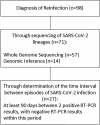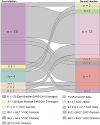SARS-CoV-2 Reinfection Cases in a Household-Based Prospective Cohort in Rio de Janeiro
- PMID: 37571849
- PMCID: PMC11032242
- DOI: 10.1093/infdis/jiad336
SARS-CoV-2 Reinfection Cases in a Household-Based Prospective Cohort in Rio de Janeiro
Abstract
This was a household-based prospective cohort study conducted in Rio de Janeiro, in which people with laboratory-confirmed coronavirus disease 2019 (COVID-19) and their household contacts were followed from April 2020 through June 2022. Ninety-eight reinfections were identified, with 71 (72.5%) confirmed by genomic analyses and lineage definition in both infections. During the pre-Omicron period, 1 dose of any COVID-19 vaccine was associated with a reduced risk of reinfection, but during the Omicron period not even booster vaccines had this effect. Most reinfections were asymptomatic or milder in comparison with primary infections, a justification for continuing active surveillance to detect infections in vaccinated individuals. Our findings demonstrated that vaccination may not prevent infection or reinfection with severe acute respiratory syndrome coronavirus 2 (SARS CoV-2). Therefore we highlight the need to continuously update the antigenic target of SARS CoV-2 vaccines and administer booster doses to the population regularly, a strategy well established in the development of vaccines for influenza immunization programs.
Keywords: COVID-19; Omicron; SARS-CoV-2 infection; reinfections; vaccine breakthrough; variants of concern.
© The Author(s) 2023. Published by Oxford University Press on behalf of Infectious Diseases Society of America. All rights reserved. For permissions, please e-mail: journals.permissions@oup.com.
Conflict of interest statement
Potential conflicts of interest. The authors: No reported conflicts of interest. All authors have submitted the ICMJE Form for Disclosure of Potential Conflicts of Interest. Conflicts that the editors consider relevant to the content of the manuscript have been disclosed.
Figures



References
-
- Bont L, Versteegh J, Swelsen WT, et al. Natural reinfection with respiratory syncytial virus does not boost virus-specific T-cell immunity. Pediatr Res 2002; 52:363–7. - PubMed
-
- Patel MM, York IA, Monto AS, Thompson MG, Fry AM. Immune-mediated attenuation of influenza illness after infection: opportunities and challenges. Lancet Microbe 2021; 2:E715–25. - PubMed
-
- Naveca FG, Nascimento V, de Souza VC, et al. COVID-19 in Amazonas, Brazil, was driven by the persistence of endemic lineages and P.1 emergence. Nat Med 2021; 27:1230. - PubMed
Publication types
MeSH terms
Substances
Grants and funding
LinkOut - more resources
Full Text Sources
Medical
Miscellaneous

